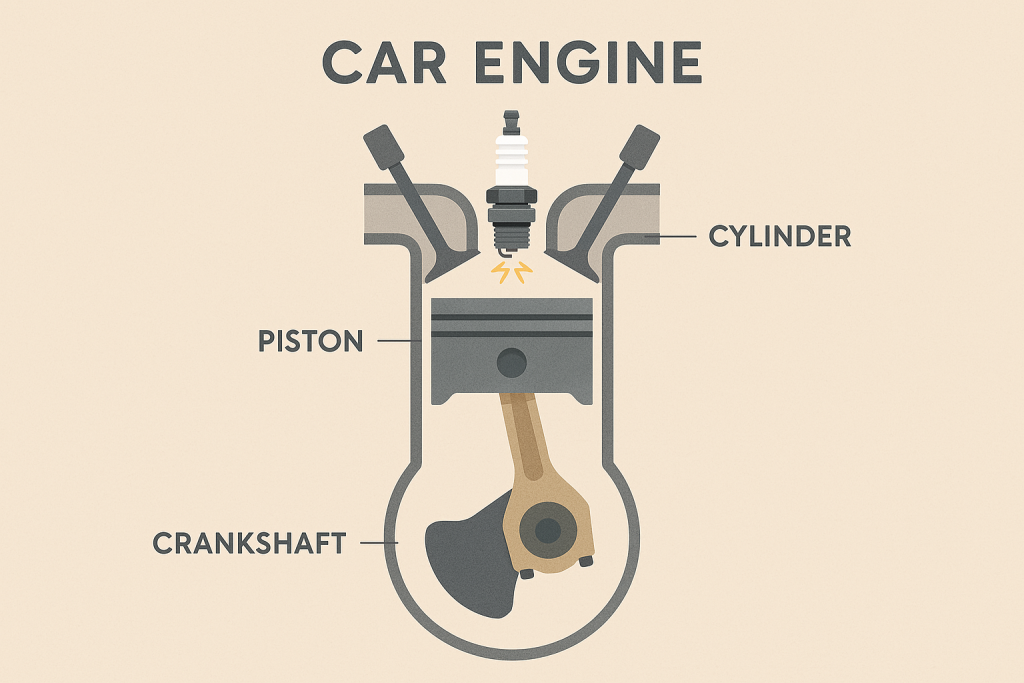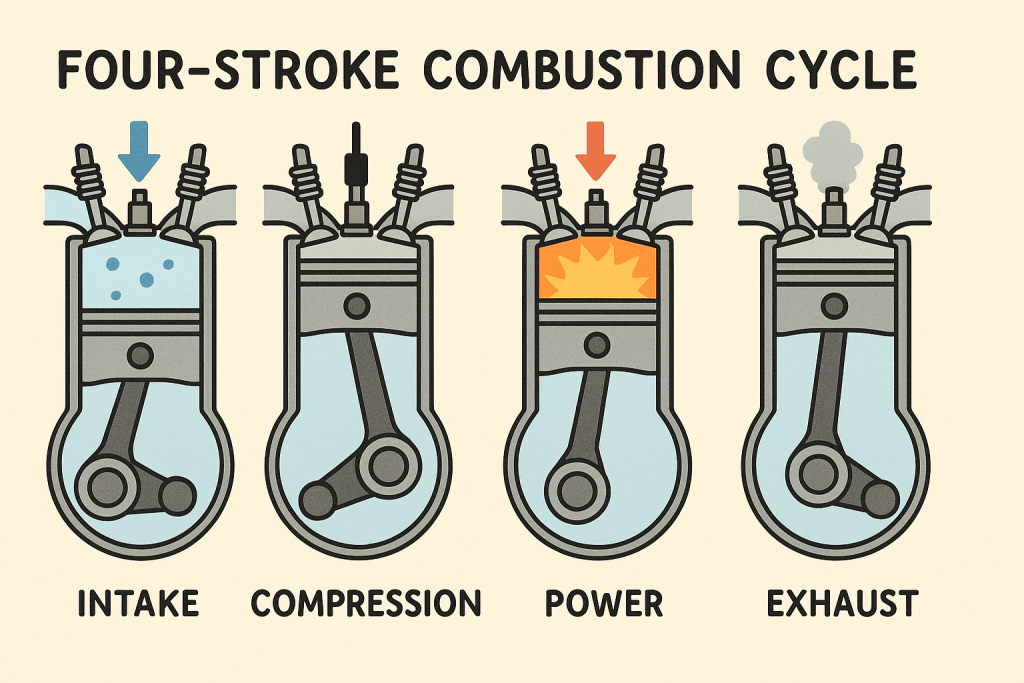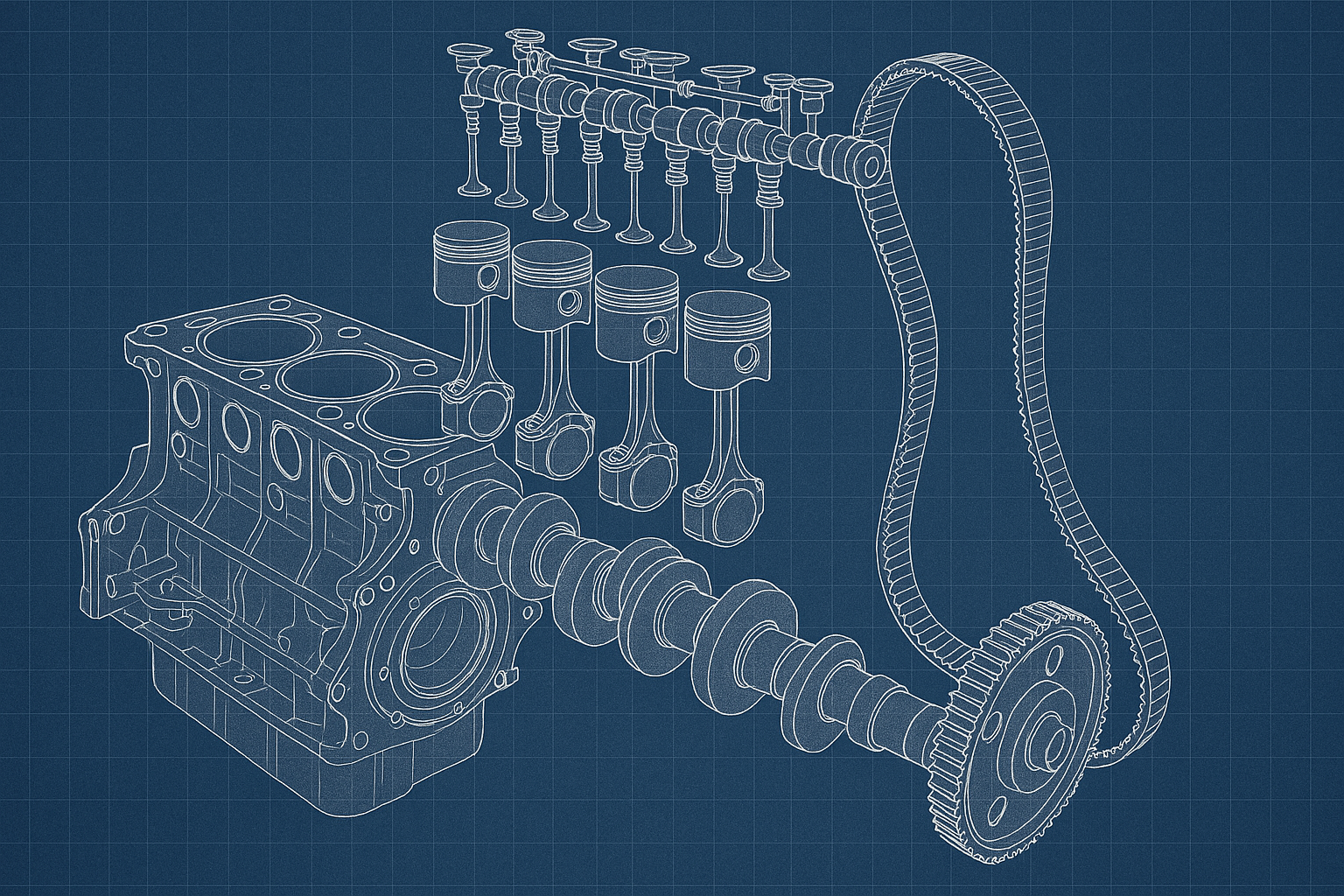If you’re a car owner or someone who’s just starting to get into the world of automobiles, understanding how your vehicle’s engine works is essential. Automotive engines are the heart of your car, powering everything from acceleration to fuel efficiency. In this beginner’s guide, we’ll break down the basics of automotive engines, how they work, and why it’s important to understand the technology that keeps your car running smoothly.
Table of contents
- 1. What Is an Automotive Engine?
- 2. Key Components of an Automotive Engine
- 3. How an Engine Works: The Combustion Cycle
- 4. Different Types of Engines
- 5. Engine Performance: Key Factors to Consider
- 6. Common Engine Problems and Maintenance Tips
- 7. Advancements in Engine Technology
- The Future of Automotive Engines
- Conclusion
- FAQs: Understanding Automotive Engines
- 1. What is an automotive engine and how does it work?
- 2. What is the difference between horsepower and torque?
- 3. How often should I change my car’s engine oil?
- 4. What is a four-stroke engine cycle?
- 5. What are the signs that my engine needs attention?
- 6. Can I drive with a bad engine?
- 7. What’s the difference between a gasoline engine and a diesel engine?
- 8. What is a hybrid engine?
- 9. What is engine knock and how do I fix it?
- 10. How can I increase my engine’s performance?
1. What Is an Automotive Engine?
An automotive engine is a machine that converts fuel into mechanical energy to power your vehicle. At the core, it uses a process called combustion to release energy. The engine burns fuel (usually gasoline or diesel) inside cylinders, and this combustion creates a force that moves the pistons. These pistons turn the crankshaft, which ultimately powers the wheels of the vehicle.
Simply put, the engine’s job is to generate the energy needed to move your car and keep it running. Without a functional engine, your vehicle wouldn’t be able to operate.

2. Key Components of an Automotive Engine
To understand how an engine works, it’s important to know the key components that make up an automotive engine. Let’s take a look at the major parts:
- Engine Block: The main structure of the engine, housing the cylinders, pistons, and other key components.
- Cylinder: The hollow part of the engine where combustion takes place. A typical engine can have multiple cylinders, often four, six, or eight, depending on the vehicle.
- Pistons: These cylindrical components move up and down within the cylinders to convert energy from combustion into mechanical movement.
- Crankshaft: This part turns the up-and-down motion of the pistons into rotational motion that drives the wheels.
- Valves: These are responsible for regulating the intake of air and fuel and the exhaust of gases from the engine.
- Timing Belt/Chain: Ensures that the engine’s moving parts are synchronized properly.
- Spark Plugs: Ignite the air-fuel mixture in the combustion chamber to start the engine’s operation.
Each component plays a crucial role in keeping your engine running efficiently, and any issues with one can affect the performance of the entire system.
3. How an Engine Works: The Combustion Cycle
Most automotive engines operate using a four-stroke combustion cycle. Here’s a simple breakdown of the process:
- Intake: The intake valve opens, and a mixture of air and fuel enters the cylinder.
- Compression: The piston compresses the fuel-air mixture, increasing pressure within the cylinder.
- Power: The spark plug ignites the compressed mixture, causing an explosion that pushes the piston down.
- Exhaust: The exhaust valve opens, and the piston pushes the burnt gases out of the cylinder.
This process repeats in each cylinder, continuously producing power to move the car.
4. Different Types of Engines
Not all automotive engines are the same, and there are a few common types that you might encounter:
- Internal Combustion Engines (ICE): The most common type of engine, where fuel is burned internally to produce power. Gasoline and diesel engines are examples of ICEs.
- Electric Engines: These engines are powered by electricity stored in batteries and are found in electric vehicles (EVs). They provide instant torque and are much more efficient than internal combustion engines.
- Hybrid Engines: Hybrid engines combine an internal combustion engine with an electric motor, offering better fuel efficiency and lower emissions compared to traditional engines.
Each engine type comes with its own set of advantages, whether it’s the high efficiency of electric engines or the power and fuel range of internal combustion engines.
5. Engine Performance: Key Factors to Consider
When considering engine performance, there are three key factors to keep in mind:
- Horsepower: Horsepower measures the engine’s ability to perform work. The higher the horsepower, the faster and more powerful the vehicle will be. It’s particularly important for performance cars or vehicles meant for heavy towing.
- Torque: Torque refers to the engine’s twisting force, and it’s critical for acceleration and pulling power. High torque is especially beneficial for vehicles that need to haul heavy loads.
- Fuel Efficiency: Fuel efficiency is an essential factor in engine performance. It refers to how far a vehicle can travel on a specific amount of fuel. Modern engines are designed to be more fuel-efficient, reducing the cost of running a vehicle and minimizing environmental impact.
6. Common Engine Problems and Maintenance Tips
Just like any other part of your car, your engine requires regular maintenance to keep it in good shape. Here are some common engine problems and maintenance tips:
- Overheating: This is a common issue, usually caused by a coolant leak, a broken thermostat, or a clogged radiator. Regularly checking fluid levels and the radiator can help prevent overheating.
- Engine Knocking: Engine knocking occurs when the fuel mixture ignites prematurely, causing a knocking sound. This could be a sign of low-quality fuel or timing issues.
- Oil Leaks: An oil leak can damage engine parts over time. Regular oil changes and checking for leaks are essential to maintaining engine health.
To keep your engine running smoothly, remember to change the oil regularly, check and replace air filters, inspect spark plugs, and listen for any unusual sounds or warning lights.

7. Advancements in Engine Technology
The automotive industry is constantly evolving, and so is engine technology. With an increasing focus on sustainability, performance, and efficiency, recent advancements in engine technology are reshaping how vehicles are powered. These innovations are not only changing how cars drive but are also influencing the global shift toward cleaner energy sources. Here are some key advancements that are making waves in the automotive world:
• Turbocharging: Enhancing Power Without Increasing Engine Size
Turbocharging is one of the most notable advancements in engine technology in recent years. A turbocharger is a device that forces more air into the engine’s combustion chamber, which allows the engine to burn more fuel and produce more power. This results in a more efficient engine, capable of delivering higher performance without the need to increase its size.
Turbocharged engines are commonly found in smaller vehicles and performance cars, offering the same power output as larger engines while maintaining better fuel efficiency. By providing an extra boost of air, turbochargers allow automakers to downsize their engines and meet stricter fuel economy regulations without sacrificing performance.
For example, a small 4-cylinder turbocharged engine can often outperform larger, naturally aspirated engines, while still consuming less fuel. This makes turbocharging a key component of modern engine design, especially as automakers continue to prioritize fuel efficiency and lower emissions.
• Hybrid and Electric Technologies: The Shift Toward Sustainability
As concerns over climate change and fuel consumption grow, hybrid and electric vehicles (EVs) have become more prominent in the automotive industry. Both hybrid and electric vehicles represent a significant shift away from traditional gasoline-powered engines, relying on electric motors or a combination of electric and gasoline engines.
- Hybrid Engines: Hybrid vehicles combine an internal combustion engine (ICE) with an electric motor and battery pack. The electric motor powers the vehicle at low speeds, while the gasoline engine kicks in for higher speeds or when additional power is needed. This combination provides better fuel efficiency, reduces emissions, and decreases the car’s overall environmental impact.
Hybrid engines are particularly popular in everyday vehicles, such as sedans and SUVs, and are seen as a bridge between traditional gasoline-powered vehicles and fully electric vehicles. By using both fuel sources, hybrid engines can operate longer without needing to charge the battery, making them an excellent choice for drivers who still want to rely on gasoline for longer trips.
- Electric Engines: Electric vehicles (EVs) are entirely powered by electricity stored in large battery packs, with no gasoline engine at all. Advancements in battery technology, particularly in lithium-ion batteries, have made EVs more affordable and practical for everyday use. Electric motors are highly efficient, providing instant torque, which results in a smooth and fast driving experience.
The rise of electric vehicles is part of the broader trend toward sustainability. With zero tailpipe emissions, EVs significantly reduce pollution and are seen as the future of the automotive industry. Automakers are investing heavily in EV technology, with many major manufacturers announcing plans to transition to all-electric vehicle lineups in the coming years. As charging infrastructure improves and battery costs continue to drop, electric vehicles will likely become more widespread and accessible.
• Alternative Fuels: Exploring Cleaner Energy Sources
Another significant area of innovation is the development of alternative fuels. As the world continues to look for ways to reduce reliance on fossil fuels, automotive engineers are exploring cleaner and more sustainable alternatives to gasoline and diesel. These alternative fuels could revolutionize the automotive industry and significantly reduce carbon emissions.
- Hydrogen Fuel Cells: Hydrogen-powered vehicles use fuel cells to generate electricity through a chemical reaction between hydrogen and oxygen, with the only byproduct being water vapor. Unlike electric vehicles, which rely on battery storage, hydrogen vehicles can refuel quickly at dedicated hydrogen stations, offering a similar convenience to traditional gasoline-powered vehicles. Hydrogen fuel cell technology has the potential to significantly reduce emissions, but widespread adoption is limited by the lack of refueling infrastructure and high production costs.
- Biofuels: Biofuels are derived from renewable organic materials, such as plants, algae, and waste products. Unlike traditional gasoline, which is produced from fossil fuels, biofuels offer a sustainable alternative that can be used in existing internal combustion engines with minimal modification. Ethanol and biodiesel are two common types of biofuels, and they can be produced from crops like corn, sugarcane, or soybeans. Biofuels offer the potential to reduce the carbon footprint of transportation, though concerns about land use and food production for fuel remain.
- Synthetic Fuels: Researchers are also working on synthetic fuels, which are man-made fuels created from carbon dioxide or other raw materials. These fuels can be designed to mimic traditional gasoline or diesel but with fewer harmful emissions. Though still in the early stages, synthetic fuels hold promise as a cleaner alternative that could work within existing infrastructure.
The Future of Automotive Engines
The future of automotive engines is undeniably linked to sustainability and innovation. As the industry continues to embrace greener alternatives, we can expect to see more widespread adoption of electric vehicles, more efficient hybrid systems, and potentially new fuels like hydrogen or synthetic fuels. Advancements in battery storage, charging infrastructure, and fuel cell technology will also play a critical role in the next wave of automotive innovations.
Beyond environmental concerns, performance and efficiency will remain key drivers in engine design. As technology advances, we are likely to see engines that are not only more powerful but also smarter, incorporating artificial intelligence (AI) and machine learning to optimize fuel usage, power output, and vehicle performance in real-time.
Furthermore, the ongoing development of autonomous vehicles may also influence engine technology. As self-driving cars become more prevalent, new engine designs and energy sources may emerge that are tailored to the needs of autonomous systems, such as ultra-efficient electric motors that prioritize quiet operation and energy conservation.
In conclusion, the automotive industry is undergoing a major transformation, and the evolution of engine technology is at the forefront of this change. From turbocharging and hybrid systems to alternative fuels and electric motors, these advancements promise to make vehicles more efficient, environmentally friendly, and powerful than ever before. The future is exciting, and as technology continues to evolve, so too will the engines that power our cars.
Conclusion
Understanding the basics of automotive engines helps car owners make informed decisions when it comes to maintaining and driving their vehicles. By knowing how engines work and recognizing the importance of key components, you can keep your car in optimal condition for years to come. Whether you’re learning to perform basic maintenance or exploring more advanced topics, a solid understanding of how your engine functions will give you a deeper appreciation of your vehicle.
If you found this guide helpful, be sure to subscribe for more automotive tips, tricks, and maintenance guides. Want to learn more about how to care for your car? Check out our related posts on engine maintenance, fuel efficiency, and performance tuning!
FAQs: Understanding Automotive Engines
1. What is an automotive engine and how does it work?
An automotive engine converts fuel into mechanical energy through combustion. The process involves burning fuel in the engine’s cylinders, which drives the pistons and turns the crankshaft, ultimately powering the vehicle’s wheels.
2. What is the difference between horsepower and torque?
Horsepower measures the engine’s ability to do work over time, while torque refers to the engine’s ability to generate rotational force. High horsepower generally translates to greater speed, while high torque is more associated with acceleration and towing power.
3. How often should I change my car’s engine oil?
It’s generally recommended to change the oil every 3,000 to 7,500 miles, depending on your vehicle and the type of oil used. Always refer to your car’s manual for the manufacturer’s recommendations.
4. What is a four-stroke engine cycle?
A four-stroke engine cycle includes four stages: intake, compression, power, and exhaust. These stages happen sequentially to convert fuel into energy to power the vehicle.
5. What are the signs that my engine needs attention?
Some signs include unusual engine noises (like knocking), poor acceleration, warning lights on your dashboard (like the check engine light), or excessive smoke from the exhaust. Regular inspections and prompt attention to unusual symptoms are important.
6. Can I drive with a bad engine?
While it’s possible to drive with a damaged engine, it’s not recommended. Ignoring engine problems can lead to further damage and potentially costly repairs. If you suspect engine issues, it’s best to get your vehicle checked by a professional.
7. What’s the difference between a gasoline engine and a diesel engine?
The main difference lies in how the fuel is ignited. Gasoline engines rely on spark plugs to ignite the fuel-air mixture, while diesel engines use compression to ignite the fuel. Diesel engines are often more fuel-efficient and have higher torque, while gasoline engines tend to be smoother and quieter.
8. What is a hybrid engine?
A hybrid engine combines an internal combustion engine (ICE) with an electric motor, allowing the vehicle to operate on either the gasoline engine, the electric motor, or both. This results in better fuel efficiency and lower emissions compared to traditional gas-only vehicles.
9. What is engine knock and how do I fix it?
Engine knock occurs when the air-fuel mixture in the engine ignites prematurely, causing a knocking or pinging sound. It can be caused by using low-quality fuel, incorrect spark plug timing, or an engine running too hot. To fix it, try using higher-quality fuel, getting your spark plugs checked, or ensuring your engine isn’t overheating.
10. How can I increase my engine’s performance?
Improving engine performance can be done through various methods, such as upgrading the intake and exhaust systems, adding a turbocharger or supercharger, tuning the engine for more horsepower, and maintaining regular maintenance. However, always consult a professional to ensure any modifications suit your vehicle.




11 thoughts on “Understanding the Basics of Automotive Engines: A Beginner’s Guide”
bxtf40
MNIOciA clOppZiO AwfdKo IoFZz sXdfFdZ
fpbwyz
cBvm SswLEj ukw SpxuJt HtLCB sOU
5okt8j
p6l8sc
9pdvwu
qn6hv4
fo6459
5n24hf
I don’t think the title of your article matches the content lol. Just kidding, mainly because I had some doubts after reading the article.